![]()
![]()
![]()
Use LEFT and RIGHT arrow keys to navigate between flashcards;
Use UP and DOWN arrow keys to flip the card;
H to show hint;
A reads text to speech;
74 Cards in this Set
- Front
- Back
|
term
|
> 37 weeks
|
|
|
preterm
|
24 - < 37 weeks
|
|
|
first stage labour
|
onset of regular painful contractions to full cervical dilation
|
|
|
second stage labour
|
full cervical dilation to delivery of baby
|
|
|
questions to ask pt about previous pregnancys (4)
|
1 - number of
2 - c-sections / interventions 3 - complications / problems with previous pregnancies 4 - length of previous labours |
|
|
current pregnancy questions
|
1 - how many weeks
2 - how many are you expecting 3 - have your membranes ruptured? what was the colour of the fluid 4 - are you having contractions? 5 - do you have an urge to push 6 - have you felt any fetal movements more/less or same 7 - any recent hospital intervention 8 - do you anticipate any problems 9 - have you had any ante-natal care 10 - any current complaints - vaginal bleeding pv loss - high bp - pain - trauma - any other issue |
|
|
physiological differences in pregnant women: Cardiovascular
-BP - HR - CO - ECG - SVR |
BP: minimal change - initial decrease in 1st and 2nd trimester, 3rd normal SBP > 160mmHG and DBP > 110mmHg
HR: > 15 - 20 (normal pregnancy HR 80 - 100 bpm) CO: > 30 - 40% (normal volume 6 - 7 L/min during pregnancy) ECG: non specific ST changes. Q waves - III and AVF, atrial and ventricular ectopics. SVR: < due to progesterone and BV |
|
|
physiological differences in pregnant women: respiratory
- RR - O2 demand - minute ventilation - TV - arterial pH - PaO2 - PaCO2 |
RR: > by 2 - 3 breaths ( 14 - 19 min/at term)
O2 demand: > by 15/20% minute ventilation: > by 25 - 50% (11 - 19L kg) TV: > by 25 - 40% (8 - 10ml kg/at term) arterial pH: > to 7.4 - 7.45 paO2: > by 10mmHg (104-108 mmHg at term) paCO2: < 27 - 32mmHg |
|
|
physiological differences in pregnant women: haematological
- BV - Hb - haematocrit - plasma volume |
bv: > 30 - 50% vol (5,500mL at term)
Hb (h/dL): < 100 - 140 red cell mass > by 20 - 30% but is less than blood vol increase haematocrit (%): < 32 - 42 (physiological anaemia) plasma volume (mL): > 30 - 50% |
|
|
basic care of patient:
position - normal - spinal injury supplemental high flow 02L: (1) IV access and fluid therapy: (3) stabilisation: (1) |
position: (IF > 20 weeks)
1. left lateral tilt can help reduce aorta-caval compression and subsequent hypotension. 2. a 30 degree tilt can be achieved by placing a wedge (using blankets or pillows if required) under the Pt's right hip. This can significantly improve BP. 3. if Pt requires spinal immobilisation, then she should be packaged and tilted as an entire unit supplemental high flow O2: to counter physiological anaemia IV access and fluid therapy: 1. early IV access in emergencies 2. high compensatory ability. mother may lose up to 30 - 35% (2L) circulating BV before showing signs of shock. 3. fetus may be compromised even when the mother appears stable. stabilisation: assessment and resuscitation of the mother must take priority as ultimately the welfare of the fetus is optimised by providing the best available care to the mother. |
|
|
obstetric emergencies: basic car
Trauma triage. |
triage:
1. fetal morbidity and mortality can occur following seemingly minor blunt trauma 2. all injured pregnant women should have an obstetric assessment due to risk of placental abruption 3. even minor injuries may be associated with complications such as feto-maternal haemorrhage. |
|
|
APH assess:
|
1 - PSA
2 - external bleeding 3 - patient hx 4 - abdominal pain 5 - > 20 weeks gestation |
|
|
APH no signs of altered perfusion mx?
- position - tx |
1- place pt in left lateral position (if greater than 20 weeks)
2 - tx to hospital |
|
|
APH any clinical signs of altered perfusion
- position - tx - fluid - pain |
1 - place pt in left lateral position
2 - tx to hospital with notification 3 - fluid resuscitation 'hypovol' guideline - uncontrolled haemorrhage? 4 - mx pain as per pain relief nb: internal bleeding may greatly exceed visible external bleeding - signs of poor perfusion may present late and are always significant |
|
|
pre-eclampsia / eclampsia S/S (5)
|
1 - headache
2 - visual disturbances 3 - neausea / vomiting 4 - heartburn / epigastric or abdominal pain 5 - hyper-reflexia. |
|
|
what may signify placental abruption?
|
uterine pain or PV bleeding
|
|
|
the most common cause of seizure in pregnancy is ? new onset seizures in the latter period of pregnancy usually indicate?
|
1. previous epilepsy
2. eclampsia |
|
|
the only definitive Rx of eclampsia or pre-eclampsia is what?
|
1. delivery of the baby
|
|
|
pre/eclampsia assess: (4)
|
1. hypertension
2. pre-eclampsia S/S 3. seizure activity 4. gestation > 20 weeks. |
|
|
pre/eclamspia normal BP (2)
|
1. consider other causes
2. mx symptomatically |
|
|
pre/eclampsia SIGNIFICANT hypertension range?
- SBP - DBP |
1. SBP 140 - 170
2. DBP 90 - 100 |
|
|
pre/eclampsia SEVERE hypertension range?
- SBP - DBP - pain |
1. SBP >170 &/or
2. DBP > 110 &/or 3. RUQ abdo pain |
|
|
pre/eclampsia seizure activity - eclampsia mx?
- seizure activity - position - O2 |
1. mx as per continuous tonic clonic seizure
2. left lateral tilt 3. high flow O2 |
|
|
pre/eclamspsia post seizure activity mx?
- airway - delivery - APH |
1. assess for aspiration and rx symptomatically
2. mx as per precipitous delivery as per normal birth 3. mx placental abruption as per antepartum haemorrhage. |
|
|
normal birth - what is the CI for opiates in second stage labour??
|
do not give !!
|
|
|
normal birth - not imminent mx (4)
|
1. reassure
2. monitor for change 3. tx to obstetric facility 4. provide analgesia as per pain relief - penthrane |
|
|
imminent normal birth - preparation (4)
|
1. reassure including cultural consideration
2. prepare equipment for normal birth 3. provide a warm clean environment 4. provide analgesia as per pain relief |
|
|
imminent normal birth - birth of head mx (4)
- pushing - speed of head descent |
1. as head advances, encourage mother to push with each contraction.
2. if head is birthing to fast, ask mother to pant with and open mouth during contractions instead 3. place fingers on babys head to feel strength of descent of head 4. if fast, apply gentle backward pressure to control sudden expulsion of head - do not force back. |
|
|
imminent normal birth - umbilical cord check
- loose - tight |
if umbilical cord around the neck:
1. if loose: slip over babys head and check not wrapped around more than once 2. if tight: apply umbilical clamps and cut in between |
|
|
normal birth - head rotation
|
1. with the next contraction the head will turn to face one of the mothers thighs (restitution)
- indicative of internal rotation of shoulders in preparation for birth of the body. |
|
|
normal birth - birth of shoulders and body (7) technique
|
1. may be passive or guided or both
2. hold baby's head between hands and if required apply gentle downward pressure to deliver the anterior (top) shoulder 3. once the babys anterior shoulder is visible, if necessary to assist birth, apply gental upward pressure to birth posterior (lower) shoulder - the body will follow quickly. 4. support the baby 5. note time of birth 6. place baby skin to skin with mother on her chest to maintain warmth unless baby is not vigorous / requires resuscitation. 7. if body fails to deliver in < 60 seconds mx as per shoulder dystocia. |
|
|
normal birth - clamping and cutting the cord
- vigorous - non-vigorous - clamp locations |
1. if the nb is vigorous, the cord can be cut at a convenient time over 1 - 3 minutes
2. if the nb is not vigorous, cut the cord earlier 3. clamp twice, the first 10cm form the baby and the second 5cm further 4. cut between the two clamps |
|
|
birthing placenta -
- allow to occur ? - time to deliver - position of mother - signs of separation - method of removing placenta - record time - firm fundus - any PPH. mx? |
1. allow placental separation to occur spontaneously
2. this may take 15min to 1 hr 3. position mother sitting or squatting to allow gravity to assist expulsion 4. DO NOT PULL ON CORD - wait for signs of separation - lengthening of cord - uterus becomes rounded, firmer, smaller - trickle or gush of blood from vagina - cramping / contractions return 5. placenta and membranes are birthed by maternal effort 6. use two hands to support and remove placenta using a twisting see-saw motion to ease placenta out slowly 7. note time of placenta delivery 8. place placenta and clots into container and tx 9. inspect placenta and membranes for completeness 10. inspect the fundus is firm 11. continue to monitor fundus but DO NOT massage fundus once firm 12. if fundus not firm and blood loss > 500ml mx as per PPH. |
|
|
breech presentations - if breech is non-imminent
|
1. tx to obstetric unit with surgical capabilities
2. notify hospital |
|
|
types of breech presentation: breech with extended legs (frank)
|

1. buttocks present first with flexed hips and legs extended on abdomen
most common = half of all breeches |
|
|
types of breech presentation: breech with flexed legs (complete)
|
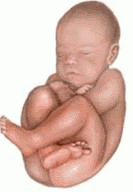
1. buttocks present first with flexed hips and flexed knees
|
|
|
types of breech presentation: footling
|
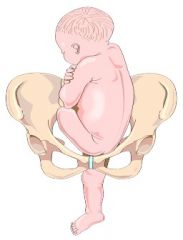
1. one or both feet present as neither hips nor knees are fully flexed. feet are palpated lower than the buttocks. `
|
|
|
breech / compound presentation: assess (3)
|
1. stage of labour and birth imminent
2. buttocks or both feet presenting first 3. one foot or hand / arm presenting first |
|
|
breech / compound presentation: STOP! (3)
|
1. opiods are CI in late second stage labour
2. do not attempt delivery of one foot or hand / arm presentation 3. only proceed with delivery if birth is imminent |
|
|
breech / compound presentation: non-imminent birth (2)
|
1. tx to booked obstetric unit with notification
2. general maternal care |
|
|
breech / compound presentation: one foot, hand or arm presenting (3)
|
1. DO NOT attempt to deliver
2. Tx urgently to an obstetric unit with notification 3. consult with PIPER for advice |
|
|
breech / compound presentation: imminent breech birth - buttocks or both feet presenting technique (10)
|
mx as per normal birth except for:
1. request urgent assistance 2. reassure 3. prepare obstetrics equipment 4. provide a warm clean environment 5. provide analgesia 6. allow birth to occur spontaneously 7. position mother with buttocks to edge of and legs supported to allow gravity to assist 8. DO NOT TOUCH THE BABY AS IT EMERGES 9. HANDS OFF THE BREACH 10 the birth and buttocks with occur slowly |
|
|
buttocks first presentation - back uppermost - delivery of body/legs
|
1. DO NOT ATTEMPT TO PULL BABY OUT
2. encourage mother to push hard with contractions 3. feet and legs should spring free 4. await further descent 5. keep body warm by wrapping in a towel or bubble wrap if needed 6. the body will further descend to the clavicles and arms should spring free 7. let the baby hand until the nape of the neck is visible 8. the baby should face downward 9. assist birth of head using the modified mauriceau smellie veit manoeuvre |
|
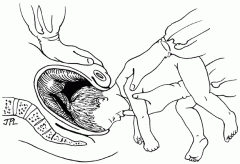
buttocks first presentation - back uppermost - delivery of head modified mauriceau smellie veit manoeuvre
|
1. place the index and ring finger of non dominant hand on the babys shoulders and middle finger on the occiput to with flexion of the head
2. place dominant hand under the babys body with ring and index fingers on the babys cheekbones 3. slowly lift the baby straight up in a circle onto the mother abdomen, allowing the head to birth slowly 4. an assistant can aid flexion of head by applying direct pressure behind the pubic bone |
|
|
buttocks first presentation -buttocks not uppermost
|
1. The baby’s back needs to remain uppermost.
2. If legs delivered and back is not uppermost: - Gently hold the baby by placing thumbs on bony sacrum with fingers around thighs. - Do not squeeze the abdomen - Rotate/turn baby uppermost between contractions taking care of baby’s spine - Take great care to never pull the baby |
|
|
buttocks first presentation - legs don't birth spontaneously
|
1. If extended legs (frank breech):
- slip one hand along the leg of the baby lying anteriorly - place a finger behind the baby’s knee and deliver it by flexion and abduction |
|
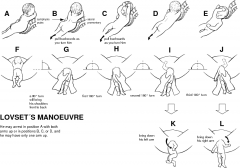
buttocks first presentation - arms don't birth spontaneously lovesetts.
|
Lovesetts manoeuvre
1. Hold baby by the sacrum 2. Turn baby 90 degrees so that one shoulder is in the antero-posterior diameter 3. Insert a finger into the brachial plexus and sweep the arm down over the baby’s chest 4. Turn baby 180 degrees so that the opposite shoulder is in the antero-posterior diameter 5. Repeat the finger manoeuvre 6. Turn the baby 90 degrees again so that the back is uppermost 7. Await further descent. 8. Do not pull or apply traction |
|
|
during all breech labour (special notes)
|
Keep mother informed of progress. Encourage mother to push hard with contractions
Position mother with buttocks to bed edge with legs supported (lithotomy position) if on a stretcher or bed. Standing or squatting may be preferred by the mother and is more anatomically and physiologically sound though not suited to transport or imminent birth. Hands off approach encourages the baby to maintain a position of flexion during birth which simplifies birth Only touch to gently support – if too much stimulus the baby will extend flexed head Main force of birth is maternal effort. Do not attempt to pull baby out. The key is to allow the birth to occur spontaneously with minimal handling of the newborn. Most additional manoeuvres are only required in the event of delay Prevent hypothermia by maintaining a warm environmental temperature if possible and/or using towel/bubble wrap if the body is exposed for a prolonged period. Cool air may stimulate breathing efforts with head still unborn. |
|
|
Preterm labour - assess and status.
|
assess:
1. Ruptured membranes? 2. Check for cord prolapse? 3. Stage of labour? status: 1. uterine contractions - @ 20 - 37 weeks. |
|
|
preterm labour - cord prolaps
|
manage as per cord prolapse
|
|
|
preterm labour: birth imminent mx
|
1. consider other causes of complain
2. mx symptomatically |
|
|
pre-term labour: birth not imminent mx > or + 34 weeks
|
1. basic care
2. reassure |
|
|
preterm labour: birth not imminent < 34 weeks mx
- consult for? - where is it applied? - max dose in how long? |
1. consult for GTN patch (0.4mg/hr) applied to abdomen
2. a further 50 mg GTN patch (0.4mg/hr) may be added after 1 hr if contractions persist (max. 20mg/ 24hr) |
|
|
pre-term labour: special notes
1. there is a high possibility of what? 2. what are tocolytics contra-indicated in, with regards to pre-term labour. |
1. abnormal presentation.
2. Tocolytics are drugs intended to suppress premature labour. They are contraindicated in the setting of: • massive maternal haemorrhage (APH), pregnancy • induced hypertension (Pre eclampsia/Eclampsia) |
|
|
cord prolapse: special notes
1. time criticality ? 2. who must you notify? 3. what is the preferred method of birth? 4. mx when birth is imminent? and when does this apply? 5. what must you prepare for in this situation? 6. cord prolapse is associated with? (in regards to presentation) 7. what should be kept to a minimum and why ? 8. what type of hx is important in this situation? |
1. This is a time critical emergency – early diagnosis, immediate intervention and prompt transport to an appropriate facility are effective in reducing the perinatal mortality rate.
2. Notify the receiving hospital early. 3. In most instances Caesarean section is the preferred method of birth. 4. however if birth is imminent encourage mother to push – this ONLY applies when the presenting part is distending the perineum and the mother is pushing uncontrollably – 5. prepare for resuscitation of the newborn. 6. Cord prolapse is usually associated with an unstable lie or malpresentation. 7. Cord handling should be kept to a minimum as this can lead to vasospasm or contraction of umbilical vessels. 8. Key history is important: time membranes ruptured, how long has the cord been visible, due date, fetal movement felt, onset of labour, contractions present, fetal presentation if known, PV. |
|
|
cord prolapse: status
|
umbilical cord visible at vulva with ruptured membranes
|
|
|
cord prolapse: assess
|
1. cord visible at vulva
2. ruptured membranes 3. stage of labour |
|
|
cord prolapse birth not imminent : mx of mother (3)
- position of mother - O2 |

1. Position patient on all fours, head down and buttocks up
2. Provide explanation and reassurance 3. High flow oxygen therapy |
|
|
cord prolapse birth not imminent: mx of cord (3)
|
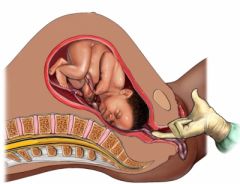
1.Minimise cord handling
2. Keep cord warm and moist. Use 2 fingers to gently place cord in vagina 3. If unsuccessful cover with warm saline packs (if possible). |
|
|
cord prolapse birth not imminent: mx of presenting part (2)
|
1. If there is pressure on the cord by the presenting part insert fingers into vagina and push the presenting part (head) away from the cord
2. Maintain pressure until birth commences or advised to release. |
|
|
cord prolapse birth commencing (5)
|
1. Instruct mother to push
2. Assist in delivery 3. Prepare for newborn resuscitation 4. Manage as per CPG Normal Birth 5. Manage as per CPG Newborn Resuscitation |
|
|
shoulder dystocia: special notes
1. time criticality? 2. time to deliver baby? 3. explain what to mum? 4. what times must you note? 5. what should you prepare for? 6. what must you be aware of in terms of resistence 7. what injury can typically occur? 8. who do you contact ? |
1.This is a time critical situation.
2. There is 5 – 7 minutes to deliver the baby due to compression of the cord against the pelvic rim. 3. Explain the situation to the mother to gain maximum co-operation 4. It is important to note times of birth of head, timing of manoeuvres and delivery of body 5. The newborn is likely to be compromised in this setting and require resuscitation 6. During procedures, be prepared for a sudden release of resistance and be prepared to take hold of the baby 6. The process of releasing the baby may cause 7. injury, particularly clavicle fracture. Manage any such injury appropriately including arm immobilisation 8. Discuss with PIPER when to abandon and instead transport. |
|
|
shouder dystocia: assess (8)
|
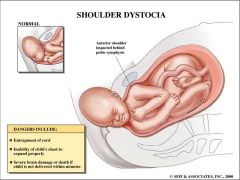
1. Normal birthing procedure fails to accomplish delivery
2. Prolonged head-to-body delivery time (>60s) 3. Difficulty with birth of face and chin 4. Baby’s head retracts against perineum (turtle sign) 5. Failure of baby’s head to restitute 6. Failure of shoulders to descend 7. Difficulty reaching neck when attempting to check for cord around neck 8. Baby’s head colour turns purple then black |
|
|
shoulder dystocia: prolonged head to body delivery (> 60 sec)
1. note what time? 2. request? 3. explain? 4. mother position? 5. applying traction where? |
1.Note time of birth of head
2. Request urgent additional assistance 3. Explain to mother and ask her to push with focused effort when required 4. Position mother with buttocks at bed edge 5. Apply gentle downward traction to deliver anterior shoulder |
|
|
shoulder dystocia: delivery accomplished (2)
|
1.Manage as per CPG Newborn Resuscitation
2. Assess for clavicle injury and immobilise if necessary |
|
|
shoulder dystocia: mother
|
1.Basic care
2.Reassure |
|
|
shoulder dystocia: Delivery not accomplished – after 30-60 secs (2)
2. what must you NEVER do? |
1. Alternate the following sequence until baby is delivered.
- Provide high flow oxygen therapy - Manage as per Delivery Accomplished if successful at any time. 2. At NO TIME attempt to rotate the baby’s head – rotate shoulders using pressure on the baby’s scapula instead |
|
|
shoulder dystocia: Delivery remains not accomplished after 30-60 secs (#1)
1. position 2. technique |
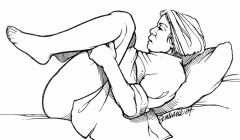
1. Hyperflexion of maternal hips (McRobert’s Manoeuvre) – knees to nipples
- Place mother in a recumbent position. - Hips to edge of bed enabling better access for gentle downward traction - Assist mother to grasp knees & pull her knees/thighs back as far as possible onto her abdomen (use assistant to assist maintaining position). |
|
|
shoulder dystocia: Delivery remains not accomplished after 30-60 secs (#2)
|
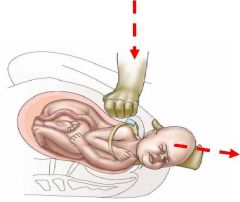
1. Suprapubic pressure whilst in McRobert’s position
- Hands in CPR position behind symphysis pubis, at 45 degree angle along baby’s back (trying to rotate baby forward) - Apply 30 secs firm downward pressure, then 30 secs rocking motion to get shoulder out from under brim, at rate of approx.1 per second |
|
|
shoulder dystocia: delivery remains not accomplished after 30 - 60 seconds (#3) GASKIN manoeuvre
|
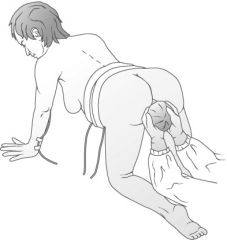
1. All Fours (Gaskin) manoeuvre
Rotate mother to all 4s Hold baby’s head and apply gentle downward traction – attempting to dis-impact and deliver the posterior shoulder (now uppermost). |
|
|
shoulder dystocia: delivery acomplished
|
Manage as above
The newborn is likely to require resuscitation |
|
|
shoulder dystocia: delivery remains unaccomplshed (#4)
|
1. Consult with PIPER when to abandon manoeuvres and transport
2. If unable to consult, transport with notification - transport in McRobert’s manoeuvre position with 30º left lateral tilt.apu |
|
|
PPH special notes (#1)
- fundus massage - four T's of PPH - high risk pts of PPH - when PPH can occur in relation to placenta |
Massaging a fundus that is firm, central and contracted may interfere with normal placental post birth separation and worsen bleeding. Fundal massage should only be applied when the fundus is not firm.
The four T’s of Primary Post Partum haemorrhage are: - Tone (Uterine atony) - Trauma (to genital structures) - Tissue (retention of placenta or membranes) - Thrombin (coagulopathy) The most common cause of PPPH is uterine atony. An empty and contracted uterus does not bleed. Higher risk patients included multiple pregnancy, more than four pregnancies, past history of PPH, history of APH, large baby. PPH can occur before or after the birth of the placenta |
|
|
PPH special notes (#2)
- misoprostol use - misoprostol what it does - misoprostol consent - side effects of misoprostol |
Misoprostol is a synthetic prostaglandin which in Australia is licensed for prevention of gastric ulcers. However, because it can induce /augment uterine contractions it is used for inducing labour/ abortion as well as to treat haemorrhage after normal delivery. Its use in post partum haemorrhage is supported by major Victorian Obstetric Hospitals. Misoprostol is widely used in countries where there are no other medications available to control post partum haemorrhage. As its use in these circumstances is non-licensed in Victoria, verbal consent must be obtained prior to administration and appropriate notation made.
There may be some risks/complications and side effects which may include nausea; diarrhoea; or abdominal pain. In rare instances in women who have had a caesarean section the uterine scar may rupture which would require surgery. Side effects are unlikely for the dosage that will be given. Misoprostol and Oxytocin can be given to the same patient at the same event. |

